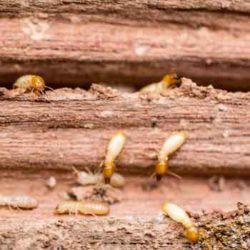Warning signs are important. Whether it’s signs on the road, labels on household chemicals, and other dangerous conditions, we encounter hundreds of warnings per day in the form of bold text, bright colors, and even flashing lights. They’re so commonplace, it’s easy to wonder how we would ever live without them.
When it comes to termites, however, the warning signs aren’t quite so obvious. There aren’t bright black and yellow signs or bold warnings posted. There’s no fine print that says, “This wall contains 187,000 wood-eating insects. This may result in a need for a carpenter or other appropriate handyman. If problem persists, contact a pest control provider for immediate relief of symptoms.”
So what are you supposed to do? If you own a Florida home that isn’t protected by a persistent termite control plan, watch out for these signs.
Termite Warning Signs
Termite Swarmers
When a termite colony matures to a certain point, it will produce termite swarmers to spread. These are long-winged insects that may appear outside or inside your home. If they are outside, this is a sign that termites may be trying to find a way into your home. If they are on your inside walls, it’s especially crucial that you take notice, as this is a good indication that termites have already taken up residence inside your home.
Because termite swarmers only appear for maybe half an hour once or twice a year, be sure to check for shed wings—another sign they’ve been around. These transparent wings are often left on windowsills, foundation walls, or sticking to spider webs.
Mud Tubes
Built by subterranean termites so they can travel from the soil to your home protected from the elements, these mud tubes are often seen behind shrubs, underneath porches, behind stairs, behind washing machines, in the backs of closets, and in many other hidden places. Mud tubes can be both thin like a pencil or bulky like a large icicle. If you find some of these tubes, break off a piece and check it again in a few days. If the tube has been rebuilt, you have an active termite infestation.
Exit Holes
When drywood termites leave the nest as swarmers, they leave through exit holes in the wood they are infesting. Termite exit holes are 1/8 of an inch in diameter or smaller. After the swarmers have left the nest, nymph termites will seal up the holes using a brown cement-like material made from termite feces. If you do not see these exit holes soon after they are made, you are not likely to see them at all.
You may also see “kickout” holes from drywood termites. These tiny temporary openings will often have droppings—or “fecal pellets”—underneath them that are about 1/16 of an inch long. They may be light-colored or black, giving them a salt-and-pepper appearance, and often appear in little piles directly under a kickout hole or closeby.
Wood Damage
If you see wood damage from termites, know that you are dealing with drywood termites. Subterranean termites, by contrast, work entirely inside wood. If you find furniture that looks like it has been chewed or gnawed upon, or any other wood item or area that looks like it was attacked by a set of carving knives, this damage was most likely caused by drywood termites.
Sounds
If you press your ear up against a wall and listen closely, you may be able to hear clicking noises if there is an active infestation of termites inside. Termites make these noises as a way to communicate by banging their heads against the insides of their tunnel walls.
Schedule Your Inspection Today
Termites cost U.S. property owners billions of dollars in damage every single year. In Florida, we see both of the most destructive termite species, subterranean and drywood. This is not a pest issue you should—or can—ever live with. If you’re seeing signs of termites, contact us for an immediate inspection and treatment.



